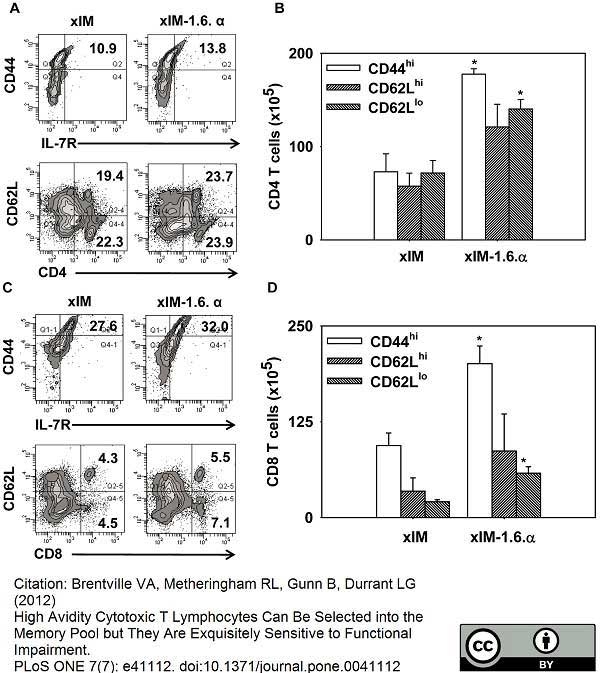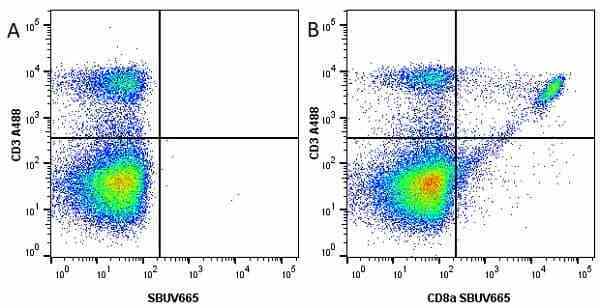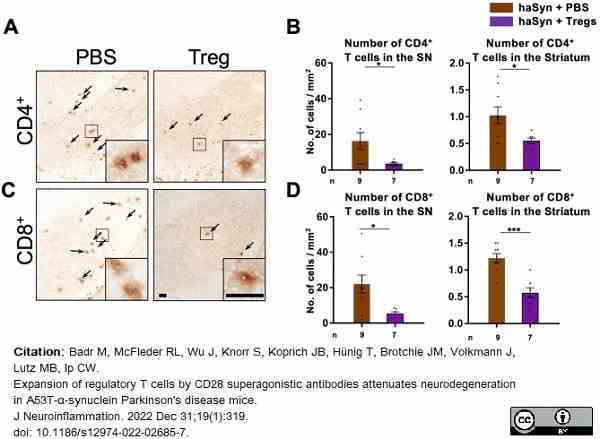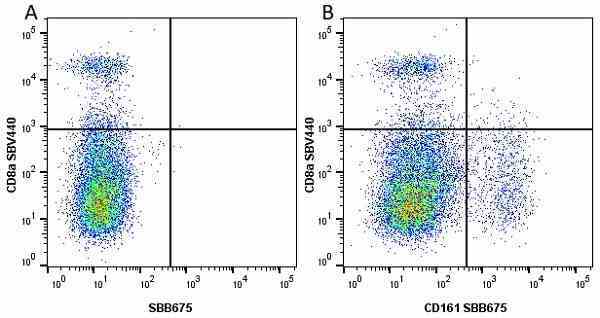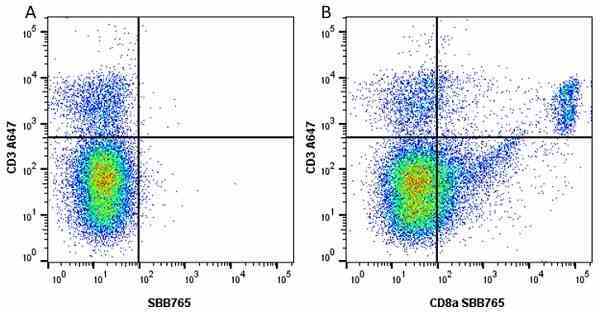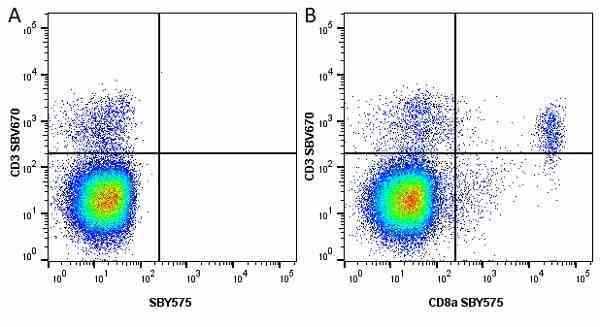CD8 Alpha antibody | KT15
























































Rat anti Mouse CD8 Alpha:StarBright UltraViolet 400
- Product Type
- Monoclonal Antibody
- Clone
- KT15
- Isotype
- IgG2a
- Specificity
- CD8 Alpha
| Rat anti Mouse CD8α, clone KT15, recognizes the alpha chain of mouse CD8. CD8 is a heterodimeric protein composed of disulphide-linked CD8α and CD8β chains that is expressed primarily on cytotoxic T-cells. CD8 functions in the interaction with MHC Class I-bearing targets and plays a role in T-cell-mediated killing (Nakauchi , H. et al., 1985 & Nakauchi, H. et al., 1987). Clone KT15 is reported to block T-cell-mediated cytotoxicity in in vitro assays (Zeis, M. et al., 2002). |
- Target Species
- Mouse
- Product Form
- Purified IgG conjugated to StarBright UltraViolet 400 - liquid
- Preparation
- Purified IgG prepared by affinity chromatography on Protein A from tissue culture supernatant
- Buffer Solution
- Phosphate buffered saline
- Preservative Stabilisers
- 0.09% Sodium Azide (NaN3)
1% Bovine Serum Albumin
0.1% Pluronic F68
0.1% PEG 3350
0.05% Tween 20 - Immunogen
- T cell clone, C6
- Fusion Partners
- Spleen cells from immunized SD rats were fused with cells of the NS0 mouse myeloma cell line
- Max Ex/Em
-
Fluorophore Excitation Max (nm) Emission Max (nm) StarBright UltraViolet 400 335 394 - Regulatory
- For research purposes only
- Guarantee
- 12 months from date of despatch
- Acknowledgements
- This product is covered by U.S. Patent No. 10,150,841 and related U.S. and foreign counterparts
This product should be stored undiluted.
| Application Name | Verified | Min Dilution | Max Dilution |
|---|---|---|---|
| Flow Cytometry | Neat |
- Flow Cytometry
- Use 5μl of the suggested working dilution to label 106 cells in 100μl. Best practices suggest a 5 minutes centrifugation at 6,000g prior to sample application.
How to Use the Spectraviewer
Watch the Tool Tutorial Video ▸- Start by selecting the application you are interested in, with the option to select an instrument from the drop down menu or create a customized instrument
- Select the fluorophores or fluorescent proteins you want to include in your panel to check compatibility
- Select the lasers and filters you wish to include
- Select combined or multi-laser view to visualize the spectra
| Description | Product Code | Applications | Pack Size | List Price | Your Price | Quantity | |
|---|---|---|---|---|---|---|---|
| Mouse Seroblock FcR | BUF041A | F | 0.1 mg |
|
Log in | ||
| List Price | Your Price | ||||||
|
|
Log in | ||||||
| Description | Mouse Seroblock FcR | ||||||
| Mouse Seroblock FcR | BUF041B | F | 0.5 mg |
|
Log in | ||
| List Price | Your Price | ||||||
|
|
Log in | ||||||
| Description | Mouse Seroblock FcR | ||||||
References for CD8 Alpha antibody
-
Tomonari, K. & Lovering, E. (1988) T-cell receptor-specific monoclonal antibodies against a V beta 11-positive mouse T-cell clone.
Immunogenetics. 28 (6): 445-51. -
Whiteland, J.L. et al. (1995) Immunohistochemical detection of T-cell subsets and other leukocytes in paraffin-embedded rat and mouse tissues with monoclonal antibodies.
J Histochem Cytochem. 43 (3): 313-20. -
Lee, Y.L. et al (2003) Oral administration of Agaricus blazei (H1 strain) inhibited tumor growth in a sarcoma
180 inoculation model.
Exp Anim. 52: 371-5. -
Eller, K. et al. (2011) IL-9 production by regulatory T cells recruits mast cells that are essential for regulatory T cell-induced immune suppression.
J Immunol. 186: 83-91. -
Grimm, M. et al. (2010) Evaluation of immunological escape mechanisms in a mouse model of colorectal liver metastases.
BMC Cancer. 10: 82. -
Liao, D. et al. (2009) Cancer Associated Fibroblasts Promote Tumor Growth and Metastasis by Modulating the Tumor Immune Microenvironment in a 4T1 Murine Breast Cancer Model
PLoS One. 4: e7965. -
Moos, M.P. et al. (2005) The lamina adventitia is the major site of immune cell accumulation in standard chow-fed apolipoprotein E-deficient mice.
Arterioscler Thromb Vasc Biol. 25: 2386-91. -
Stevenson, P.G. et al. (2002) Uncoupling of virus-induced inflammation and anti-viral immunity in the brain parenchyma.
J Gen Virol. 83: 1735-43.
View The Latest Product References
-
Wang, X. et al. (2011) Quercetin and Bornyl Acetate Regulate T-Lymphocyte Subsets and INF-γ/IL-4 Ratio In Utero in Pregnant Mice.
Evid Based Complement Alternat Med. 2011: 745262. -
Zeis, M. et al. (2002) Idiotype protein-pulsed dendritic cells produce strong anti-myeloma effects after syngeneic stem cell transplantation in mice.
Bone Marrow Transplant. 29: 213-21. -
Ideguchi, M. et al. (2008) Immune or inflammatory response by the host brain suppresses neuronal differentiation of transplanted ES cell-derived neural precursor cells.
J Neurosci Res. 86: 1936-43. -
Wolf, D. et al. (2005) CD4+CD25+ regulatory T cells inhibit experimental anti-glomerular basement membrane glomerulonephritis in mice.
J Am Soc Nephrol. 16: 1360-70. -
Severinova, J. et al. (2005) Co-inoculation of Borrelia afzelii with tick salivary gland extract influences distribution of immunocompetent cells in the skin and lymph nodes of mice.
Folia Microbiol (Praha). 50: 457-63. -
Zaini, J. et al. (2007) OX40 ligand expressed by DCs costimulates NKT and CD4+ Th cell antitumor immunity in mice.
J Clin Invest. 117: 3330-8. -
Meyer, C. et al. (2011) Chronic inflammation promotes myeloid-derived suppressor cell activation blocking antitumor immunity in transgenic mouse melanoma model.
Proc Natl Acad Sci U S A. 108: 17111-6. -
Zitt, E. et al. (2011) The selective mineralocorticoid receptor antagonist eplerenone is protective in mild anti-GBM glomeru-lonephritis.
Int J Clin Exp Pathol. 4:606-15. -
Singh, V. et al. (2011) Co-administration of IL-1+IL-6+TNF-α with Mycobacterium tuberculosis infected macrophages vaccine induces better protective T cell memory than BCG.
PLoS One. 6: e16097. -
Kalyanasundaram Bhanumathy, K. et al. (2015) Potent immunotherapy against well-established thymoma using adoptively transferred transgene IL-6-engineered dendritic cell-stimulated CD8(+) T-cells with prolonged survival and enhanced cytotoxicity.
J Gene Med. 17 (8-9): 153-60. -
Abiko K et al. (2015) IFN-γ from lymphocytes induces PD-L1 expression and promotes progression of ovarian cancer.
Br J Cancer. 112 (9): 1501-9. -
Phan-Lai, V. et al. (2016) The Antitumor Efficacy of IL2/IL21-Cultured Polyfunctional Neu-Specific T Cells Is TNFα/IL17 Dependent.
Clin Cancer Res. 22 (9): 2207-16. -
Kajiwara, T. et al. (2016) Hypoxia augments MHC class I antigen presentation via facilitation of ERO1-α-mediated oxidative folding in murine tumor cells.
Eur J Immunol. 46 (12): 2842-51. -
Srivastava, A.K. et al. (2016) Co-transplantation of syngeneic mesenchymal stem cells improves survival of allogeneic glial-restricted precursors in mouse brain.
Exp Neurol. 275 Pt 1: 154-61. -
Meier, R.P. et al. (2014) Survival of free and encapsulated human and rat islet xenografts transplanted into the mouse bone marrow.
PLoS One. 9 (3): e91268. -
Groh, J. et al. (2021) Immune modulation attenuates infantile neuronal ceroid lipofuscinosis in mice before and after disease onset
Brain Communications. 3(2): fcab047. -
Cecil, D.L. et al. (2022) COX-2 inhibitors decrease expression of PD-L1 in colon tumors and increase the influx of Type I tumor infiltrating lymphocytes.
Cancer Prev Res (Phila). canprevres.0227.2021. -
Karikari, A.A. et al. (2022) Neurodegeneration by α-synuclein-specific T cells in AAV-A53T-α-synuclein Parkinson's disease mice.
Brain Behav Immun. 101: 194-210. -
Badr, M. et al. (2022) Expansion of regulatory T cells by CD28 superagonistic antibodies attenuates neurodegeneration in A53T-α-synuclein Parkinson's disease mice.
J Neuroinflammation. 19 (1): 319. -
McFleder, R.L. et al. (2023) Brain-to-gut trafficking of alpha-synuclein by CD11c(+) cells in a mouse model of Parkinson's disease.
Nat Commun. 14 (1): 7529. -
Aloui, A. et al. (2023) AFM1 Exposure in Male Balb/c Mice and Intervention Strategies Against Its Immuno-physiological toxicity using Clay Mineral and Lactic Acid Bacteria Alone or in Combination.
Immunopharmacol Immunotoxicol. : 1-32. -
Aringer, I. et al. (2021) Agonism of Prostaglandin E2 Receptor 4 Ameliorates Tubulointerstitial Injury in Nephrotoxic Serum Nephritis in Mice.
J Clin Med. 10 (4) :832.
- Synonyms
- LY-2
- UniProt
- P01731
- Entrez Gene
- Cd8a
- GO Terms
- GO:0002456 T cell mediated immunity
- GO:0016021 integral to membrane
- GO:0007166 cell surface receptor linked signaling pathway
- GO:0009897 external side of plasma membrane
- GO:0042803 protein homodimerization activity
- GO:0045065 cytotoxic T cell differentiation
- GO:0050850 positive regulation of calcium-mediated signaling
MCA609SBUV400
If you cannot find the batch/lot you are looking for please contact our technical support team for assistance.
Please Note: All Products are "FOR RESEARCH PURPOSES ONLY"
View all Anti-Mouse ProductsAlways be the first to know.
When we launch new products and resources to help you achieve more in the lab.
Yes, sign me up










